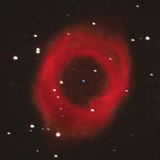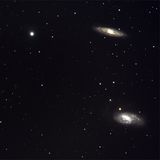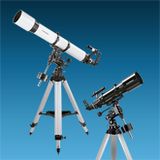
Late summer is the perfect time to begin exploring the deep sky: the objects beyond our solar system and local stars. Under a dark sky, the Milky Way stretches from the southern horizon to overhead and beyond to the northern horizon. As we look towards Sagittarius, we can see the most brilliant gems surrounding the center of our galaxy.
The birth of stars takes place in diffuse nebulae, clouds of glowing gas laced with dust, deep within our galaxy. After the dust and gas disperse, we are left with galactic star clusters, sometimes called open clusters. The last gasps of dying stars are seen as ghost-like planetary nebulae, looking like stellar smoke rings. On either side of the disk of our mighty galaxy are hordes of densely packed globular clusters, each containing a hundred thousand stars or more. And beyond our galaxy are countless more galaxies. Where to start?
Messier Hunting
Many amateur astronomers follow in the footsteps of Charles Messier, an 18th century observer of comets who made a catalog of objects in the sky which might be confused with comets, to make his searches easier. His catalog of 110 objects includes the brightest and best of the whole cosmic zoo of deep sky objects. Most astronomers refer familiarly to these objects by their "M numbers": the numbers Messier gave them in his list, though many of them have other names.
Take the Tour
If you have a computerized telescope, such as the Orion IntelliScope, you can call up "sky tours" for any particular night in the year. The IntelliScope tour for August starts out with two beautiful galactic clusters, the 6th and 7th objects cataloged by Messier, 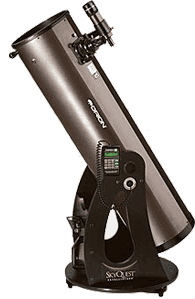 Orion XT10 Intelliscopeknown as M6 and M7. Both these clusters had been described by Ptolemy in the 2nd century as "small clouds," but your telescope will resolve them into hundreds of tiny stars.
Orion XT10 Intelliscopeknown as M6 and M7. Both these clusters had been described by Ptolemy in the 2nd century as "small clouds," but your telescope will resolve them into hundreds of tiny stars.
The next three objects on the tour are three of the finest diffuse nebulae in the sky: the Lagoon Nebula (M8), the Swan Nebula (M17), and the Trifid Nebula (M20). You have probably seen colorful images of all three made with large telescopes. The view through an amateur telescope is quite different. Our eyes are not sensitive to color in dim light, so we see these nebulae as shades of grey against a black background. In fact, if we try to observe them in the light polluted skies of a city, or on a bright moonlit night, we may not see them at all! These are true "nebulae," the Latin word for cloud, although they are clouds not of water vapor, but of hydrogen and oxygen gas, glowing in response to the bright young stars within them, to which they have just given birth.
Two more objects in the August tour represent the other end of a star?s lifetime. The so-called "planetary nebulae" are shells of gas blown off by stars towards the very ends of their lives. The Ring Nebula (M57) is a tiny smoke ring; you may need to use at least 100x magnification to see that it is a perfect little oval ring, and not a star. The Dumbbell Nebula (M27) is much larger and more diffuse than the Ring; it looks like a small puff of smoke.
The next two August objects are globular clusters, M13 and M92, both in the constellation of Hercules. Unlike galactic clusters, which are relatively small and located within our galaxy, globular clusters are much larger, denser, and located above and below the disk of our galaxy. In a small telescope, they appear like smudges of light, but as the aperture of the telescope increases, more and more of their thousands of stars are resolved into tiny pinpoints of light.
The August tour ends up with another open cluster, M11, and two of the finest multiple stars in the sky: the brilliantly colored Albireo and the Double-Double in Lyra. Use a high magnification on the last, and you will see that each of the "stars" in the double is in fact a very close pair, four stars in all.
You may have noticed that there are no galaxies on the August tour. That?s because our own galaxy, the Milky Way, dominates the August sky, and effectively blocks the light from lesser galaxies. On the whole, galaxies are much more challenging than the objects I?ve discussed here, and are best left until you have more experience with seeing the denizens of the deep.
Nebula Filters
As I mentioned above, planetary nebulae and diffuse nebulae may be hard to see under less than perfect conditions, but there is a way of enhancing their visibility. Both types of nebulae give off light of very specific wavelengths. 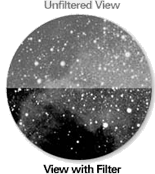 If you place a special filter in front of your eyepiece which only passes the light the nebulae give off, they will shine through, while the polluting light is dimmed. Such filters don?t make nebulae brighter; they just make everything else dimmer. The Orion UltraBlock is such a filter; I have used one for years to observe faint diffuse and planetary nebulae, and also to observe fine structure within the brighter nebulae. Orion has recently introduced a new O-III filter, which is more narrowly tuned to the two main emission lines of oxygen in these nebulae.
If you place a special filter in front of your eyepiece which only passes the light the nebulae give off, they will shine through, while the polluting light is dimmed. Such filters don?t make nebulae brighter; they just make everything else dimmer. The Orion UltraBlock is such a filter; I have used one for years to observe faint diffuse and planetary nebulae, and also to observe fine structure within the brighter nebulae. Orion has recently introduced a new O-III filter, which is more narrowly tuned to the two main emission lines of oxygen in these nebulae.
I put this new filter to the test on a recent night, using the objects on the August tour. To make matters tough, I made my observations with a bright 10-day-old Moon right in the middle of Sagittarius! The Lagoon Nebula was only 5 degrees from the Moon. I didn?t expect to see much, but the brighter western half of the nebula was faintly visible without a filter using the 25mm eyepiece in the Orion XT6. Using the UltraBlock made the western half much clearer, but switching to the O-III filter made the elusive eastern half plainly visible too. The Trifid Nebula was overwhelmed by the Moon (7 degrees away) without a filter and even with the UltraBlock, but could be seen as a faint glow with the O-III filter. The Swan Nebula was farther away from the Moon, 13 degrees, and was visible without a filter as a vague glow. Its swan shape became visible with the UltraBlock, and stood out very sharply with the O-III filter. The Dumbbell and Ring Nebulae were both about 60 degrees away from the Moon, and so not affected much by its light. Even so, the Dumbbell changed from a diffuse glow to a clear two-lobed shape as I switched to the UltraBlock and then the O-III. The Ring Nebula was the only object where I preferred the unfiltered view. Part of the beauty of the Ring for me is how it sits as an alien ring amidst the stars surrounding it. The filters dimmed the stars so that the ring appeared in isolation without its context.
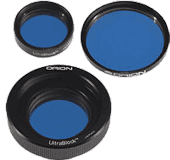 So, it's clear that the O-III filter offers enhancement of nebulae over the older UltraBlock. However, the UltraBlock would still be my first choice for scopes smaller than 8 inches aperture, because of the strong dimming effect of the O-III filter. The test objects I studied are among the brightest nebulae in the sky, so they were still visible in the 6 inch scope despite the dimming effect.
So, it's clear that the O-III filter offers enhancement of nebulae over the older UltraBlock. However, the UltraBlock would still be my first choice for scopes smaller than 8 inches aperture, because of the strong dimming effect of the O-III filter. The test objects I studied are among the brightest nebulae in the sky, so they were still visible in the 6 inch scope despite the dimming effect.
As a final test, I took a look for the famous Veil Nebula in Cygnus, the aftermath of an ancient supernova explosion. Even though it was over 70 degrees away from the Moon, it was totally invisible without a filter and with the UltraBlock. But with the O-III, it formed a huge glowing arc across the sky, overflowing my widest field eyepiece.
Deep sky filters are standard equipment in my astronomer's toolbox.
August 2005




